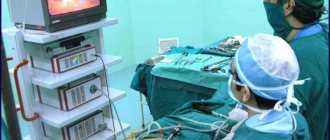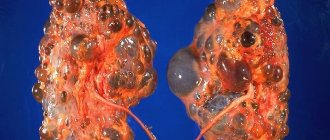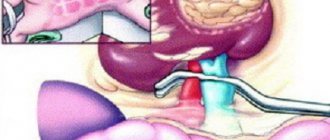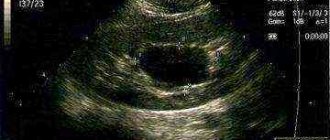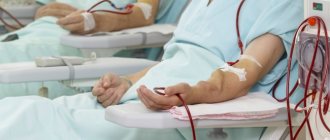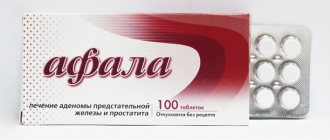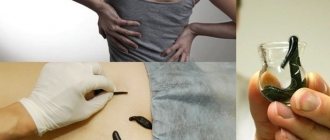- home
- Urology
- Kidney cyst
- Treatment methods
Organ-preserving surgery - laparoscopy of a kidney cyst. More than 250 operations were performed.
The widespread introduction of ultrasound into medicine has led to an increase in the number of patients with identified kidney cysts.
A kidney cyst is a spherical cavity filled with fluid, which, unlike a kidney tumor, is most often benign. In 70% of cases, the cyst can be monitored dynamically without resorting to active surgery.
Operations in the 90s
The kidneys perform many functions in the body, the main ones being cleansing the body of harmful substances and excess water. This is a paired organ with an oval shape. The kidneys are located below the ribs, closer to the spine area.
It is because of this location that for a long time operations were performed with an incision in the lumbar region. There are many intertwined muscles in this area. Their incision increased the complexity of the operation and the duration of the recovery period. Renal laparoscopy was first performed only in the 90s.
The main methods of surgical treatment of kidney cysts
Removal of a kidney cyst is performed in various ways depending on the indications and condition of the patient at the time of surgery. We would like to draw your attention to the fact that there are methods such as:
Puncture. This method involves removing the cyst through a puncture needle with puncture of the surrounding soft tissue. Laparoscopic method. It is performed with penetration into the abdominal cavity. The cyst is removed through the ventral (abdominal) approach. Direct surgical removal through the dorsal (dorsal) approach in the lumbar region. Retrograde method. This is a minimally invasive technique, the essence of which is to guide a special probe with a laser tip and a camera through the urinary tract and remove the fluid filling the cyst.
Each of the listed methods of tumor removal has its own positive and negative sides. The operating surgeon chooses the method in accordance with the patient's health condition.
Laparoscopy of a kidney cyst: a brief description
The method was first used in 1992. This is a surgical operation that is performed through small punctures. Their number is no more than 6 pieces, and their sizes are from 5 to 10 mm. Monitoring the progress of the operation is carried out using mini-video cameras, which are initially inserted through punctures.
During laparoscopy, carbon dioxide is used, which expands the walls of the peritoneum. This ensures free movement of the instruments. The operation allows you to remove tumors of any size and complexity, including multiple ones.
Kitectomy laparoscopic
Operations of this kind began to be carried out in 1992. It allows the patient to be relieved of a number of formations of various sizes and nature. This is also an option for low-traumatic surgical intervention.
In modern medicine, laparoscopic removal of a kidney cyst is most often performed. This is largely due to minimal pain and trauma for the patient. It only takes a couple of days to recover from the experience.
During the planning of such an operation, the specialist will prescribe an ultrasound examination to clarify the position and condition of the tumor.
For interventions of this type, general anesthesia is used in most cases. But if surgery is required for a child, endotracheal anesthesia is also an option.
First of all, the puncture is performed in the navel area on the stomach. Additionally, a couple more cuts are required. They are made in different places, based on the characteristics of education in a particular case. It is through them that the necessary instruments are inserted - a probe equipped with a camera, an endoscope and a laparoscope,
Indications for surgery
The cyst can have different sizes and types. Sinus tumors are simple tumors. They may be filled with cystic fluid mixed with blood. The parenchymal capsule is often congenital, rarely acquired. Such a tumor may disappear on its own. A solitary cyst is also a simple cyst. Most often it affects only one kidney. The capsule has purulent or hemorrhagic contents.
A cyst is a benign neoplasm. If it is more than 3 centimeters, then surgical intervention may be required. Indications for it are:
- severe aching or sharp pain;
- purulent processes,
- compression of the ureter, which disrupts the normal outflow of urine;
- risk of transformation of the capsule into malignant;
- abscess;
- cysts from 10 centimeters;
- destruction of kidney tissue;
- rupture of the cyst and spillage of its fluid;
- increased kidney blood pressure (vascular hypertension);
- the appearance of blood in urine;
- detection of cancer cells in the capsule.
Initially, a cystic neoplasm may not manifest itself at all (especially when it is small in size). With intensive growth, pain and other symptoms appear.
Treatment and operations
We use this method when the kidney cyst is technically inaccessible for puncture, the size of the cyst exceeds 7-8 centimeters, or there is a suspicion of malignancy. Laparoscopic surgery is performed using 3 punctures no longer than 5 mm and is characterized by the absence of pain and inflammation. Although this is a full-scale operation, patients can be discharged after two days. We also use laparoscopic surgery when there are parasitic, hydatid cysts of the kidneys and liver.
Abdominal surgery to remove a cyst - in extremely rare cases, when neither puncture nor laparoscopic surgery can be used due to various contraindications, we are forced to resort to standard abdominal surgery. Also, abdominal surgery can be used for traumatic rupture of a kidney cyst. Unfortunately, we are often forced to use abdominal surgery when there is a suspicion of an alveococcal cyst of the kidney and liver.
The procedure for removing a renal cyst and its features
Most kidney cysts are caused by congenital conditions, while others are caused by infection, injury, surgery, or drugs. The fluid collects in the space surrounded by the connective tissue capsule; it is a clear saline solution that matches the composition of blood serum.
To identify cystic formations, contrast studies are required - ultrasound, computed tomography or magnetic resonance imaging. The choice depends on the exact question, the location of the cyst, and the imaging already performed.
The surgical technique is determined by the size and location of the tumors. For safe extraction, minimally invasive intervention is preferred. Currently, an endoscopic approach through the abdominal cavity is often chosen. The goal is to preserve as much kidney tissue as possible.
Benign large cysts that cause symptoms can be punctured and drained. If a neoplasm is suspected, it is recommended to seek advice from a qualified specialist.
Kidney growths require surgery if they cause discomfort. Also, surgery to remove a cyst on the kidney is performed if it is impossible to reliably exclude a malignant disease. As the cyst grows in size, it often displaces the surrounding tissue, leading to pain. If multiple neoplasms are present, this will limit renal function.
It is important to distinguish between solitary renal cysts and polycystic disease. Surgical removal is possible only for a small number of cysts. The relapse rate is relatively high when surgery is used; It is preferable to perform surgery if symptoms have already arisen.
Main contraindications:
- decompensated diabetes mellitus;
- absence of symptoms of the disease;
- severe polycystic kidney disease;
- cardiopulmonary diseases in the decompensation phase;
- disorders of the blood coagulation system.
Preparation for surgery should be carried out according to the doctor’s recommendations. 24 hours before the procedure you need to avoid eating food, psychotropic substances (nicotine, alcohol, caffeine) and medications. The patient must undergo basic examinations in advance: urine, blood, ECG and abdominal ultrasound.
You must inform your doctor in advance about taking anticoagulants (acetylsalicylic acid or coumarin derivatives), as they increase the risk of peri- and postoperative complications.
Approximately 50% of type III cysts are malignant. The surgeon's actions depend on the appearance of the lesion and range from exploration and biopsy to nephrectomy. The current standard approach is open surgery with partial nephrectomy. Simple renal cysts rarely require surgery.
Main surgical treatment options:
- aspiration and puncture;
- sclerotherapy;
- open nephrectomy;
- laser cyst removal;
- open abdominal surgery;
- percutaneous resection;
- laparoscopic resection.
Let's try to figure out whether it is always necessary to remove a cyst on the kidney. Surgical indications for cystic kidney disease vary depending on the underlying disorder. Multicystic dysplastic kidney (MDK) must be treated to prevent subsequent development of symptoms.
Currently, however, surgery to remove a kidney cyst is only indicated if it interferes with respiratory or gastrointestinal function, or significant hypertension develops. Cyst ruptures, occurring spontaneously or secondary to trauma, also require surgical intervention.
In autosomal dominant polycystic kidney disease (ADPKD), significant chronic pain may result from tumor expansion. Cyst aspiration is usually the first-line treatment.
Some patients are recommended to undergo laparoscopic cyst removal. However, for the treatment of severe pain, hypertension, hematuria, or infection, open surgery may be preferable.
Complex cysts can be removed or examined laparoscopically. Studies have shown good results with this method using a retroperitoneal approach. Patients are often interested in how long laparoscopy to remove a kidney cyst lasts. The procedure can take from 30 minutes to 2 hours. The duration depends on the number of cysts and the experience of the surgeon.
Percutaneous resection is another surgical option used to treat symptomatic cysts. It involves making a skin incision, dilating the urinary tract, and then inserting a resectoscope. 13 years of experience with this method have shown that 100% of patients experience clinically significant improvements after the procedure with minimal complications.
Nephrectomy can be performed at the same time as kidney transplantation to relieve symptoms associated with PKD. Data suggest that open nephrectomy at the time of transplant is associated with fewer perioperative complications than laparoscopic bilateral nephrectomy. In extreme cases, severe pain (in the left or right side) and enlargement of the liver may occur. Partial hepatectomy (removal of the liver) can relieve these symptoms.
For autosomal recessive polycystic kidney disease (abbreviation: ARPKD), patients with severe portal hypertension may undergo sclerotherapy to control bleeding. Splenectomy (removal of the spleen) may be indicated for splenomegaly (enlarged spleen) with significant complications. When combined with peritoneal dialysis, kidney transplantation was associated with an increase in 5-year survival rate of up to 83% in one series.
In acquired renal cystic diseases, persistent or severe hemorrhage may require nephrectomy or embolization. If a 3-cm mass is identified, indicating renal cell carcinoma, a partial or radical nephrectomy is performed. The patient must be operated on by an experienced surgeon.
A randomized controlled trial that compared percutaneous sclerotherapy with laparoscopic sclerotherapy for symptomatic renal cysts found that both procedures were safe and had equal effectiveness. The scientists also concluded that sclerotherapy is associated with lower morbidity and shorter hospital stays.
In the postoperative period, it is necessary to observe 2-3 days of bed rest. No special dietary restrictions are required. It is recommended to avoid eating spicy, fried or excessively fatty foods. The duration of sick leave depends on the severity of the surgical intervention and averages 20 days. After laparoscopy, the patient can return home after 2 days.
Every operation carries the risk of certain complications. They can affect the wound area or the entire body and appear during and after the intervention. Possible consequences:
- bleeding;
- infection;
- impaired wound healing and scars;
- thrombosis;
- pneumonia and pulmonary embolism;
- nerve damage;
- cardiovascular shock;
- metabolic disorders, water, electrolyte balance.
Recurrences of kidney cysts are not noticed by many patients. They can grow to gigantic sizes during the course of the disease and then lead to back pain, abdominal pain and high blood pressure. Malignant tumors rarely develop from cysts.
Methods for removing cysts on the kidney
A kidney cyst is a biological cavity of a round or ellipsoidal shape, always filled with fluid. The formation can be localized anywhere in the kidneys, both outside and under the epithelium. The pathology is diagnosed in more than 5% of the world's population, but in the case of a simple formation not burdened by negative dynamics, the cyst does not require removal. If development and growth of education is observed, surgical intervention is required, distinguished by types, duration of the rehabilitation period and other characteristics. A recommendation to remove a kidney cyst can only be given by a specialist based on the collected tests and the patient’s medical history!
Indications and contraindications for surgery
Surgical intervention is used in cases where conservative therapy is ineffective
Surgical intervention is used in cases where conservative therapy is ineffective, in particular:
- Pain syndrome that does not go away for a long time. It can be a sharp or dull aching pain;
- Growth of the cavity up to 10 cm or more;
- Pressure and obstruction of a cyst on the kidney to the normal outflow of urine;
- Fluid infection, suppuration, abscess caused by cystosis;
- Atrophy or necrosis of renal tissue and the development of vascular hypertension of the kidney;
- Rupture of the cystic bursa and spillage of the contents into the abdominal cavity;
- Blood in the urine;
- The dynamics of the transformation of a benign tumor into a malignant one, the presence of cancer cells in the cystic fluid.
Important! Practice shows that if the renal cyst already exceeds the size of 3 cm, then sooner or later the patient will be referred for surgery. In most cases, the pathology is supplemented by constant pain, general weakness and other signs of malaise.
Contraindications for surgery:
- Exacerbation of diabetes mellitus;
- Diseases of the cardiovascular and respiratory systems;
- No symptoms of the disease;
- Chronic or acute inflammatory processes in the peak stage;
- Allergic reactions;
- Seasonal diseases.
Preoperative preparation
In order for the surgery to be as successful as possible, the patient must pass all tests
In order for the surgical intervention to be as successful as possible, the patient must strictly follow the doctor’s recommendations:
- Avoid taking medications and folk remedies that thin the blood.
- Surgery is stressful for the immune system, so it is important to avoid hypothermia and colds.
- The operation should not be performed in case of cyclic bleeding in women; the optimal time is 7-20 days of the cycle.
- Be sure to pass the required tests: blood, urine, ECG and undergo other prescribed procedures. The statute of limitations for analyzes cannot be later than 28 days. Often, ultrasound and computed tomography are required to determine the dynamics of development.
- The recommended diet must be followed both before and after surgery. As a rule, this is the exclusion of dairy products, some vegetables and fruits. Before the day of surgery, you need to refuse dinner, do an enema, and 8-9 hours before the procedure, do not eat or drink, unless this is prohibited for medical reasons.
Sometimes it is necessary to remove hair, but some doctors are against this procedure, but it doesn’t hurt to wash yourself thoroughly, as well as to remove the piercing.
Types of surgery
Complete removal of cyst formations is performed with open abdominal surgery
Today, there are several methods for removing cysts. Complete removal of cyst formations is carried out during open abdominal surgery, which involves excision of part of an organ or the entire kidney, but such cases are rarely used and for health reasons. The laparoscopic removal of a kidney cyst and other minimally invasive methods are not an operation in the full sense, since the leathery sac is not removed, but the walls of the formation collapse.
By type of access, surgical intervention is divided as follows:
- Retrograde, carried out by inserting an endoscope into the urethra;
- Percutaneous – treatment carried out through a puncture in the abdominal or dorsal area.
Important! Only the doctor treating the patient can choose the right treatment method after collecting all the tests. If the patient is not entirely confident in his specialist, he should contact different clinics to get the most optimal diagnosis: not all medical institutions are equipped with the latest technology, so the types of intervention offered may differ from abdominal surgery to non-surgical cyst removal. The latter type is possible given that the dynamics of formation are sluggish, the cavity is not enormous in size and is not prone to rupture.
Percutaneous puncture sclerotherapy
Most often, this method is called cyst removal without surgery.
A folk method of cleansing the kidneys! Our grandmothers were treated using this recipe...
Cleaning your kidneys is easy! You need to add it during meals...
Most often, this method is called cyst removal without surgery. Being the least traumatic, this type of intervention does not imply complete removal of the formation, only evacuation of the liquid filling and prevention of the development of pathology by introducing a sclerosing agent. The method is used only for simple cysts that are not burdened by multilocularity or a tendency to transform into malignant tumors.
The procedure is carried out by medical professionals using an ultrasound machine. A preliminary study of the image allows you to accurately select the puncture site, and the point should be close to the center of the cyst formation. The patient is most often placed on his side to fix his body position throughout the operation. Local anesthesia, minimal dissection, and surgical insertion of the tube are careful and quick. The tube remains in the patient's body until the cystic contents are completely evacuated, after which a sclerosing agent is injected through the same tube. The composition is removed after 5-20 minutes.
Important! Sclerotherapy is carried out once, or less often twice. 14 days after the procedure, the patient is required to undergo an ultrasound scan to confirm the effectiveness of the procedure. In cases of relapse (re-filling of the cyst with fluid), repeated punctures or radical operations are indicated.
Laparoscopic cystectomy
This is an operation to remove cysts, which is by far the most common and provides a 98% effectiveness of complete cure without relapse.
This is an operation to remove cysts, which is the most common today and provides a 98% effectiveness of complete cure without recurrence. Laparoscopy allows you to destroy cysts of complex shapes, multi-chamber, large-sized, while the method is considered the most painless and minimally traumatic for the patient. The preparation methods are identical: ultrasound examination, selection of the puncture site, but here most often the patient lies on his back, and general anesthesia is already in place.
Important! If laparoscopic surgery is performed on children, endotrachial anesthesia is used: general anesthesia with a tube in the throat.
There are three punctures of the abdominal wall: gas is injected through a puncture in the peri-umbilical region to simplify the viewing of the entire clinical picture; the other two puncture sites are determined after examining the cyst. Then the instruments are inserted, with which the surgeon separates the cyst from the organ and performs aspiration, after which the vessels are “sealed” to prevent bleeding and the formation is excised. A drainage tube remains in the puncture; it is removed after a day; the punctures are sutured.
It should be noted that the incisions are minimal (0.5 cm), there is no risk of infection, the rehabilitation period is short, so most often the attending physician prescribes laparoscopic intervention if there are no contraindications. Despite the simplicity of the process, the operational process requires the conditions of a professional medical clinic and specialized personnel. Cureability prognoses reach 95%.
Retrograde intrarenal intervention
A characteristic feature of the operation is the insertion of an endoscope through the urethra.
A characteristic feature of the operation is the insertion of an endoscope through the urethra. The procedure is carried out under general anesthesia and after excision of the cyst, the walls of the sac are not removed, but are sutured to the tissues. Subsequently, the cyst scars and the patient does not experience negative sensations.
Important! After this operation there are no punctures or stitches on the body, as with laparoscopy. But many experts do not recommend this type of intervention due to the high degree of risk: suturing the cystic sac with the tissues of the cavity of the genitourinary system is not considered favorable - such a technique often leads to the development of pathologies with the slightest inflammation or the dynamics of a malignant formation that cannot be detected in advance.
That is why, despite all the aesthetic advantages of the operation, retrograde interventions are rarely performed. The main indications for implementation are an inconvenient location of the cyst, for example in the lower part of the left kidney.
Open abdominal surgery
Today, open intervention is performed in 5% of kidney cysts detected and the operation is always performed under general anesthesia
The type is the most traumatic and affects a wide area of the incision. Indications for abdominal surgery can only be extensive tissue damage, malignancy of the formation, or rupture of the cyst with spillage of the contents into the abdominal cavity. Today, open intervention is performed in 5% of kidney cysts detected and the operation is always performed under general anesthesia. The procedure is complex and involves cutting the soft tissue to expose the organ, then the doctor determines (visually or by palpation) the location of the formation, makes a puncture and sucks out the contents of the cyst. The kidney is excised until the walls of the cystic sac are exposed, which are then sewn with a special thread to the edges of the wound.
Important! A dye may be injected to identify the thinned walls of the cystic sac. The walls are excised and stitched, but if there is no tightness of the seam and visible separation of urine, new sutures are required. If an abscess, purulent, or oncological pathologies are detected, a decision is made to remove part of the kidney or the entire organ.
Abdominal surgery is an emergency intervention option when minutes count and there is no time to select alternative methods for removing cysts in the kidney.
Rehabilitation
On average, the recovery period takes 30-40 days, but it all depends on the type of surgery, the patient’s age, his immunity and the presence of chronic diseases. Regardless of the procedure, it is better to spend the first couple of days in bed or exert minimal stress on the body. Minimally invasive methods of intervention allow the patient to go home (in the absence of negative indications) already on 2-3 days; in the case of open operations, the patient spends 5-14 days in the clinic.
Even after discharge, you must continue to treat your own body and follow all the doctor’s instructions. This may include wearing a bandage, diet therapy, taking painkillers, anti-inflammatory medications, or antibiotics. A follow-up examination of the patient is prescribed every 4-6 months to confirm positive dynamics and prevent the development of relapses.
Cash costs for paid surgical treatment
The price for laparoscopy varies widely: from 50,000 to 220,000 Russian rubles. The operation can be performed in almost any urological medical center in Moscow and the Moscow region. Patients at risk can undergo free surgery under the compulsory medical insurance policy.
The cost of open surgical intervention ranges from 15,000 to 40,000 rubles. It is recommended to check the exact price of each procedure with the medical center, since it differs significantly.
Patient reviews do not reflect the objective effectiveness of individual procedures. According to urologists, puncture of the cyst relieves pain in the side and improves well-being. Laparoscopy is characterized by a high therapeutic effect if performed by an experienced surgeon.
Advantages and disadvantages of laparoscopy when removing a kidney cyst
The positive points are:
- high precision of manipulation and good efficiency;
- minimally invasive, barely noticeable traces of several punctures remain on the body (no abdominal incisions);
- low level of pain syndrome;
- fast rehabilitation times;
- negligible likelihood of postoperative relapses;
- bloodless excision of cysts using coagulation;
- applying cosmetic stitches.
The main disadvantage is the high price. It is also important to note that laparoscopy requires special equipment and qualified personnel; the latter are currently in short supply in the Russian Federation, so for treatment with this method it is necessary to select special clinics, usually located in large cities.
Reviews from doctors and patients
Patients in most cases are satisfied with the operation (we are most often talking about laparoscopy), especially if it was carried out as planned. Many carry it out under the compulsory medical insurance policy and, nevertheless, rarely encounter complications. In their reviews, patients often indicate that small scars after laparoscopy still remain, but they are barely noticeable and do not significantly affect the appearance.
Regarding surgical intervention for kidney cysts, doctors are divided into supporters of puncture with sclerosis and laparoscopy. Both methods have their advantages and disadvantages. Experts advise using the retrograde method and open surgery only in extreme cases.
Treatment of a kidney cyst often brings welcome relief and significantly improves the patient’s quality of life. The most common laparoscopic surgery is a simple, effective technique that rarely leads to complications.
Causes and symptoms of kidney cysts
- Simple renal cyst. You need to understand that the kidney is a system of tubes. For one reason or another, one of the tubes is blocked, for example, due to inflammation. Over the course of several years, fluid is slowly produced, the cavity grows and, reaching a significant size, compresses the kidney, disrupting its function.
- Parasitic kidney cyst. There are parasites that humans can become infected with, for example, from dogs. These are echinococcus and alveococcus - types of worms. Echinococcal cysts are found in the liver, lungs and kidneys. Treatment of parasitic formations of the kidney or liver should be carried out by an experienced specialist, since damage to the parasitic cyst can spread the disease.
Diagnosis of kidney cyst. Essentially, as soon as a urologist sees a patient with this diagnosis, he must answer three questions:
- What is the nature of the disease? What kind of formation is this - a simple, parasitic or hydatid cyst or a malignant cyst-kidney cancer?
- Is it necessary to operate on a kidney cyst? If it is a small benign fluid formation that does not impair kidney function, then there is no need to operate. In all other cases, surgery is necessary
- How to operate? There are at least three methods in the surgeon’s arsenal: cyst puncture, laparoscopic removal of the kidney cyst, and abdominal surgery.
These are the questions we try to answer when we prescribe a series of studies to a patient.
allows you to answer two questions: whether echinococcus or alveococcus are the cause of the kidney cyst and how affected the kidney function is. For this, a number of indicators are used: creatinine and urea, as well as indicators demonstrating the presence of allergic reactions, which is typical for parasitic cysts.
a leading study that allows not only to detect kidney formations, but also to assess whether there is compression of the ureter, whether it contains a tissue component, and whether puncture and sclerotherapy of the kidney cyst will be possible? In addition, ultrasound examination allows one to distinguish simple kidney formations from parasitic or tumor ones.
multispiral computed tomography with contrast allows you to accurately assess a number of parameters. Firstly, this is kidney function, which we evaluate using contrast. Secondly, a CT scan of the kidneys will help exclude malignant neoplasms. Thirdly, this is a necessary study for choosing a treatment method.
Disadvantages of the method
Despite the abundance of advantages, an operation such as renal laparoscopy also has its disadvantages in comparison with open surgery:
1. High cost of the operation. Due to the use of expensive equipment, the price of the operation may seem high. However, we should not forget about the long recovery period after open surgery, which requires the use of painkillers and often wearing a corset.
2. High professionalism of the surgeon and medical staff. The operation of kidney laparoscopy implies that the hospital staff has all the necessary skills to carry out such manipulations.
Indications
Scars after laparoscopic surgery
Laparoscopy is the preferred method of choice, however, at the moment in Russia it has not yet become widespread due to the characteristics of the operating equipment, the high cost and the limited number of doctors capable of performing this procedure. But every year the number of operations performed in this way is constantly growing.
In addition to cysts, it is used to eliminate the following pathologies of the genitourinary system:
- benign and malignant neoplasms (in the initial stages);
- drooping of the kidneys and bladder;
- hydronephrosis;
- renal failure.
Contraindications
Removal of a kidney cyst by laparoscopy cannot be done if the patient has diabetes mellitus in an acute stage. Also, the technique is contraindicated for:
- absence of pronounced symptoms;
- disorders of the respiratory or cardiovascular system;
- allergic reactions;
- active inflammation.
If the patient has herpetic rashes or colds with a runny nose, then the operation is performed after they are cured.
Treatment of kidney cysts without surgery is carried out if:
- There are no manifestations of pathology.
- Diagnosed with polycystic disease.
- The patient has low blood clotting.
- The patient is taking blood thinning medications, for example, Acetylsalicylic acid. The use of medications with this property is stopped a week before surgery.
- Pathologies of the cardiovascular or respiratory system.
- Acute phase of diabetes mellitus (spike in blood sugar levels).
Consequences after puncture
The patient did not experience any negative consequences after the puncture. The operation is carried out under ultrasound control; the monitor displays a detailed procedure and the structure of both the tumor and the kidney. Before the operation, the doctor prescribes the patient to take medications with antibacterial properties to prevent the risk of infection.
In rare cases, the following symptoms may appear:
- nausea and further vomiting;
- increase in temperature for a short period;
- a bruise may form at the site of the needle puncture;
- feeling weak and dizzy.
Symptoms disappear within 10-12 hours after surgery. They may pass earlier. Puncture is a modern medical method for treating kidney cysts. After undergoing the procedure, most patients do not experience a recurrence of the disease.
Reviews about kidney cyst puncture are positive from both doctors and patients.
Preparing for surgery
Before laparoscopy, special preparation is carried out. The patient should stop taking blood thinning medications. Before going to the hospital, you must avoid colds and hypothermia. For women, laparoscopy is done on days 7-20 of the menstrual cycle, when there is no bleeding.
Then blood and urine samples are taken, and patients are checked for infections. An ECG is done, then the therapist issues a conclusion. The validity period of ready-made tests is from 2 weeks to 28 days. When the day of the operation is set, the patient is given a memo that spells out all the individual examinations that need to be done additionally. For example, ultrasound, CT, Doppler examination of blood vessels, etc.
A few days before laparoscopy, the patient should begin to follow a strict diet. Some vegetables and fruits, flour and foods that cause gas formation are excluded from the diet. The evening before the operation you should not have dinner; you will have an enema. 8 hours before laparoscopy you should not drink or eat.
Before the operation, hair is removed from the abdomen and frontal area. It is advisable not to shave them off, but to cut them short. This will help avoid possible inflammation. The piercing is removed and the area around the navel is treated with an antiseptic. For varicose veins, compression garments are worn during the operation (with the doctor’s permission). It may be indicated for wearing after the procedure.
Based on the physician’s conclusion, the results of blood and urine tests, ultrasound or computed tomography, the doctor prescribes the necessary operation. Before surgery, it is recommended to follow a diet. It is necessary to exclude bread products, vegetables and fruits. It is also better not to eat dinner or drink liquids the night before surgery. Avoid hypothermia or colds.
It is advisable to perform the operation during the absence of menstruation.
Pubic and abdominal hair must be removed. To avoid skin irritation, removing hair with a razor is not recommended. You need to try to cut them as short as possible. Particular attention should be paid to the navel area: carefully wash and remove the piercing, if any.
Reasons for kidney removal and rehabilitation period
Kidney removal is a last resort measure for treating a very limited number of nephrological diseases.
The decision to perform such an operation is made only if organ-preserving therapy is ineffective and the patient’s further condition is rapidly deteriorating.
The role of the kidneys in the excretory system of the body is very important. They perform the following functions:
- cleansing the blood of nitrogenous metabolic products and various foreign toxins;
- regulation and maintenance of a constant level of electrolytes in the body;
- ensuring a constant level of fluid in all structural elements of the body, while maintaining the normal functioning of all organs and systems;
- blood pressure regulation:
- secretion of biologically active substances: renin, which is involved in maintaining normal blood pressure levels, and erythropoietin, which plays a key role in hematopoiesis.
Pathologies for which nephrectomy is indicated
As mentioned above, the efforts of doctors are always aimed at maximizing the preservation of the integrity and functions of the kidney, because even with 20% of working nephrons, it successfully copes with its “job”.
The consequences of diseases of this organ usually affect the entire body.
But for some diseases and injuries, an operation in which one kidney is removed is the only way to prevent disability or even save the patient’s life
The main indication for nephrectomy is cancer and polycystic formations.
Moreover, the operation must be performed while only one kidney is affected by the oncological process, since this type of cancer is characterized by the spread of metastases to the second kidney.
And this almost always means disability and a shortened life span for the patient.
Also, the reason for kidney removal can be the consequences of hydronephrosis. This pathological condition develops with prolonged disruption of the outflow of urine, which leads to increased pressure inside the kidney.
This causes circulatory disorders in the kidney tissue and the death of cells located in it.
Surgery to remove the kidney is also performed in case of severe trauma, when damage affects all its internal parts.
Nephrectomy procedure
As before any operation, a comprehensive examination of the patient is carried out before kidney removal.
But the main step in preparing for nephrectomy is to assess the functioning of the second kidney. For this purpose, numerous X-ray studies with contrast and MRI are performed.
In emergency cases, using a dye that is excreted in the urine, the functionality of the second organ is checked directly on the operating table.
Currently, kidney removal is performed laparoscopically. Its main advantages are:
- low invasiveness;
- relative safety;
- lower risk of complications;
- rapid postoperative recovery, after such an operation even
- disability is provided.
To do this, several incisions are made in the skin in the lumbar region. A laparoscope is inserted through them, which illuminates the operating cavity and transmits the image to a special monitor.
Also, the instruments necessary to perform a nephrectomy are brought to the damaged kidney.
Recovery period
Recovery time depends greatly on the type of surgery, but on average it takes a month. The first 1-2 days after the procedure will have to be spent in bed. Then, if your condition allows and the doctor allows, you can get up and walk along the corridor. With minimally invasive methods of surgery, you can go home already on the second or third day. The duration of hospitalization for open types of intervention is 5-7 days in the absence of complications.
Wearing a bandage may be indicated during open surgery. The patient is often prescribed painkillers, anti-inflammatory drugs and antibiotics for 7 days. The patient's condition should be monitored 4-6 months after surgery.
Carrying out the operation
Removal of a cyst on the kidney is performed laparoscopically percutaneously (with peritoneal punctures). First, the doctor examines the images obtained after the ultrasound to determine the location of the tumor. The patient lies on the couch, on his back. The operation is performed under general anesthesia. Technique:
- The first puncture is performed near the navel. Carbon dioxide is introduced into the abdominal cavity through an opening. It expands the intra-abdominal space for manipulation.
- Then several more punctures are made. A laparoscope (probe with a mini-camera) is inserted into one of them, and surgical instruments are inserted into the others. They cut off the cyst from the kidney.
- If necessary, a puncture is made in the tumor and the contents are removed.
- Then the vessels are “sealed” with endoscissors (this is done to prevent bleeding) and then the cyst is excised.
- A drainage tube is inserted into the puncture and removed after 1-2 days.
Then the punctures are sutured. The last one is when the drainage is removed. With laparoscopy, it is possible to remove the tumor with a partial amount of kidney tissue. At the same time, the organ itself is generally preserved.
After the operation, antibiotics (to prevent inflammation) and painkillers are prescribed. An ultrasound is performed to evaluate the results of surgery. If only the contents of the cyst were removed, but not its walls, then the fluid may begin to accumulate again. Then a repeat operation is performed.
Sutures are removed one week after laparoscopy. To prevent complications, the patient is recommended breathing exercises and early activation. In the first days after surgery, the patient cannot get up. You can get up and start walking slowly on the 2nd day. Most often, the patient is discharged home on the third day. The full rehabilitation period ends in a month.
At this time, it is necessary to adhere to a diet. Fatty, fried, spicy and salty foods are completely excluded from the diet. You can't drink coffee, you need to temporarily abstain from chocolate. Protein foods should be consumed in small quantities. This reduces the burden on the body and promotes rapid elimination of toxins.
It is advisable to eliminate salt completely, but if this is not possible, then its use is reduced to a minimum. This is especially important if the cyst provokes organ dysfunction and there is a risk of kidney failure. The basis of the diet should include plant foods and carbohydrates.
It is also necessary to control the volume of fluid consumed. Its amount should be reduced in patients prone to edema. Also, water volumes should be reduced for people with cardiovascular diseases or high blood pressure. In other cases, there is no need to limit the amount of liquid you drink.
It is important to give up bad habits - smoking, drinking alcohol. Physical activity is temporarily limited (it should not be excessive). Physiotherapy is indicated for faster recovery. With its help, stitches heal faster and tissues are restored.
After discharge from the hospital, the doctor sets a schedule of examinations. If complications arise, additional treatment is carried out. Recurrence of cysts after laparoscopy is extremely rare. To monitor your kidneys, you need to undergo an ultrasound and examination by a nephrologist or urologist 1-2 times annually.
Postoperative period and rehabilitation
A successful operation is half the battle. Rehabilitation after removal of a kidney cyst is of great importance, since if certain recommendations are violated, serious complications may develop. The patient should remain in bed for 24 hours after the procedure. The next day, short walks around the ward are allowed. Depending on the progress of recovery, the patient should stay in the hospital for 3-7 days. Within 2 months, rehabilitation is completed and the person can return to their normal lifestyle.
After abdominal surgery, the recovery course is much longer than after other methods of cyst removal. If there are no complications, the patient has to stay in the hospital for about 3 weeks. Since the surgical intervention left a large wound, it is necessary to constantly apply dressings and monitor the condition of the stitches. The doctor prescribes the use of antibiotics, anti-inflammatory and painkillers.
The rehabilitation period depends on the type of surgery, but on average lasts about a month.
Diet
Despite the fact that removal of a kidney cyst is often carried out quickly and without complications, it is a serious stress for the body, affecting all systems. To ensure a quick recovery and no complications from the urinary system, the patient is prescribed a diet. Lack of dietary control in the postoperative period leads to the development of an inflammatory process in the operated kidney. To prevent this from happening, you must adhere to the following rules:
- Minimize salt intake. If a kidney cyst provokes functional disorders of the organ and there is a threat of developing renal failure, salt consumption should be completely stopped.
- If the presence of a cyst has led to the development of pathologies of the cardiovascular system and the presence of edema, you need to limit the amount of fluid you drink.
- During recovery, you need to avoid eating fried and fatty foods, spices, herbs, sauces, marinades, coffee, chocolate, and any acids.
- A complete cessation of bad habits is required.
- The basis of the diet should be carbohydrates and plant fiber. Protein consumption should be kept to a minimum so that toxins do not accumulate in the body, since in the first time after surgery the urinary system cannot be fully stressed.
Upon discharge from the hospital, the doctor sets a schedule for follow-up examinations. If complications develop, additional therapy is carried out. Recurrence of cystic formations is rare. To monitor the general condition of the kidneys and timely detection of possible pathologies, it is recommended to undergo an ultrasound, x-ray and consult with a urologist or nephrologist 1-2 times a year.
Consequences and possible complications
Laparoscopy is characterized by a short recovery period and the absence of complications. However, they may occasionally appear. Complications can arise if the surgeon has no experience in performing such operations or lacks the necessary qualifications. Sometimes internal organs are damaged during surgery. This occurs when tubes and instruments are inserted into the abdominal cavity.
There is also a danger when carbon dioxide is injected into the stomach. It can get into the subcutaneous fat layer, which is fraught with complications in the future. Sometimes blood vessels are damaged during manipulation. In this case, bleeding occurs. One of the characteristic complications after laparoscopy is frequent urination.
Cost of the procedure
Laparoscopy can be performed free of charge in any government institutions if they have the necessary equipment. However, if necessary (or if desired), you can have the operation performed in private medical centers, but this is paid. The price can be quite high. This is largely determined by the use of expensive equipment, hospitalization costs, and medications.
On average, laparoscopy in Moscow costs 100 thousand rubles. This cost includes the hospitalization period (up to three days), tests, ultrasound, and postoperative recovery. Without hospitalization, the price of laparoscopy can range from 3,000 rubles. If sclerotherapy is done, the cost will increase by approximately 20 percent.
According to reviews from doctors and patients, the laparoscopy method is assessed positively, as it has many advantages:
- Short rehabilitation period. For a person to fully recover, 7-10 days are enough.
- Laparoscopy leaves almost no marks on the body, only small stitched wounds that are almost invisible. Sometimes the punctures heal so much that they are not visible at all.
- The operation is rarely accompanied by infection.
- Minimal risk of ventral hernias and adhesions.
Also, doctors and patients note that after laparoscopy, sick leave is not required, the operation is characterized by little pain and there is no need to take potent drugs to eliminate it. If necessary, analgesics are prescribed only in minimal dosages.
Kidney cysts need to be monitored and treated. If the tumor increases in size, pain and other negative symptoms appear. If not treated in a timely manner, complete atrophy of the affected kidney is possible.
basic information
Multiple cysts on the kidney
A cyst in the kidney is a benign cavity formation filled with certain contents, usually fluid. When the size is small (up to 3 cm), it is observed or conservative treatment is carried out. At large values, increased pressure is created on the tissues of the organ, which causes dysfunction and discomfort. In this case, surgical intervention is required.
The reasons for the formation of pathology can be various, for example, injuries, infections and others. The neoplasm originates from epithelial cells of the kidney tubules.
The abnormal cells grow and fill with fluid. Cysts can be single (solitary) or multiple. They reach up to ten centimeters in size and even more.
Note. Typically, the presence of neoplasia does not make itself felt in any way and is often discovered by chance during non-targeted ultrasound examination, less often during other types of diagnostics.
